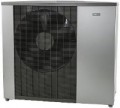Max. heat output
The maximum heat output generated by a heat pump is the amount of heat it can transfer from the outdoors into the heating system and/or domestic hot water.
The heat output is the most important spec of a heat pump. It directly determines its efficiency and ability to provide the required amount of heat. Note that this spec is shown for optimal operating conditions. Such conditions are rare, so the actual output heat is usually noticeably lower than the maximum; this must be taken into account when choosing. There are special formulas for calculating the optimal value of the maximum heat output, depending on the specific condition.
Heat output (~ 0 °C)
Heat output is the amount of heat generated by a heat pump at a source temperature (air or ground - see above) of about 0 °C. This indicator is more visual and closer to reality than the maximum heat output (see above), so it is often indicated in the characteristics as the main one.
The required heat output depends on the area and some features of the room, on the need for hot water and a number of other factors; for its calculation in special sources, you can find the appropriate formulas.
Max. cooling output
Maximum cooling output delivered by the pump.
The pump operates in the cooling mode removing excess heat from the room to the environment — it plays the role of an air conditioner. The required cooling capacity depends on the area of the building, the specs of its thermal insulation and some other factors; methods of its calculation can be found in special sources. Also note here that conventional heating equipment (radiators, underfloor heating) is not suitable for cooling, for this it is necessary to use special equipment (for example, fan coil units).
Power consumption (heating)
Electric power consumed by the heat pump when operating only for heat transfer, without the use of an additional heating element (if any, see below). The ratio of thermal power to power input determines the thermal coefficient COP (see below) and, accordingly, the overall efficiency of the unit. It also affects overall power consumption (and therefore electricity bills), as well as some power and connection requirements — for example, models powered by 230 V and with a power of more than 5 kW cannot work from an outlet and require a special connection to the mains.
Minimum operating temperature
The lowest ambient temperature (air or ground, see Heat source) at which a heat pump can safely and reasonably efficiently perform its functions. Efficiency at minimum temperature, of course, is noticeably reduced, but the device can still be used as a heat source.
The data on the minimum operating T allows you to evaluate the suitability of the pump for the cold season.
Max. water temperature
The highest temperature to which the pump can heat the coolant. It is worth noting that such indicators can be achieved at a fairly high temperature of air or ground. And since heat pumps are used during the cold season, the actual maximum temperature, usually, is less than theoretically achievable. Nevertheless, this parameter makes it possible to evaluate the capabilities of the unit or its suitability for certain tasks.
Compressor
The compressor is the main element, the "heart" of the unit: it circulates the coolant through the heat pump circuits and transfers heat from outdoors to the room. Knowing the name of the compressor, you can find detailed information about it and find out some features of the heat pump as a whole. Note that the name is usually indicated if the device uses a high-end compressor, often an inverter one.
— Inverter. The presence of a compressor with inverter power control in the heat pump. Models without an inverter have only two modes of operation — either on or off; and the set intensity of heating/cooling is provided by turning the compressor on and off for certain periods. In turn, the principle of inverter control is to smoothly change the compressor power, which avoids constant switching on and off. It provides many advantages: minimal wear, no power surges and unnecessary load on the electrical mains, as well as a comfortable (low and stable) noise level.
COP
The COP (coefficient of performance) is a key characteristic that describes the overall efficiency of a heat pump. It represents the ratio between the thermal power and power consumption of the unit (see above) – in other words, how many kilowatts of thermal energy the pump produces per 1 kW of electricity consumed. In modern heat pumps, this figure can exceed 5.
However, note that the actual COP value may vary depending on the outside temperature and the supply temperature. The higher the difference between these temperatures, the more resources are needed to “pump” thermal energy and the lower the COP will be. Therefore, in the specifications it is customary to indicate the COP value for specific temperatures (and in many models – two values, for different options) – this allows you to evaluate the actual capabilities of the unit.
COP
Additional heat coefficient COP specified in the specifications in addition to the main one. For more information about the meaning of this indicator, see the "COP" above. And an additional coefficient is indicated for operating temperatures other than the main one — this allows you to evaluate the capabilities of the pump in different conditions.

